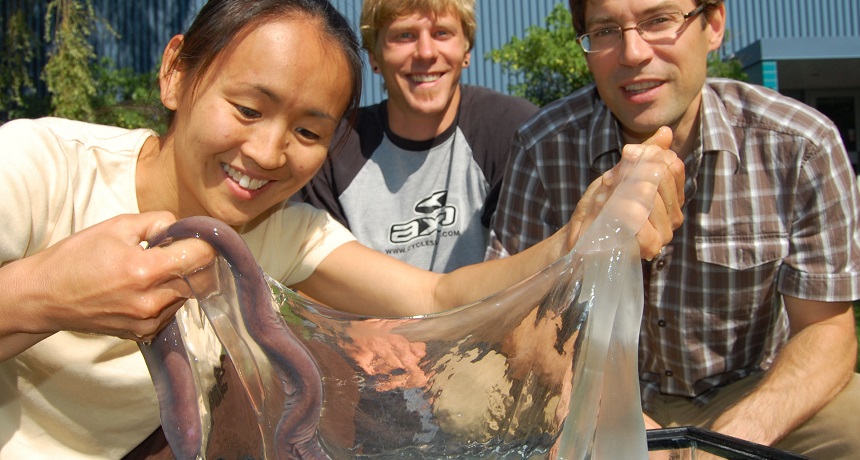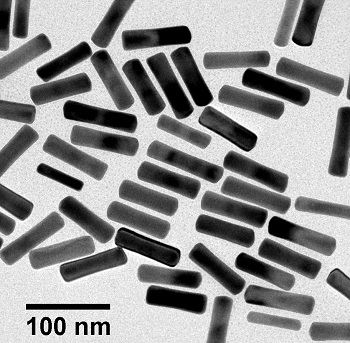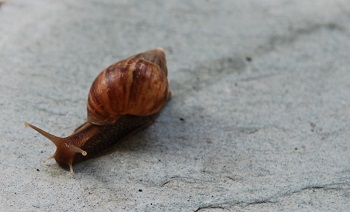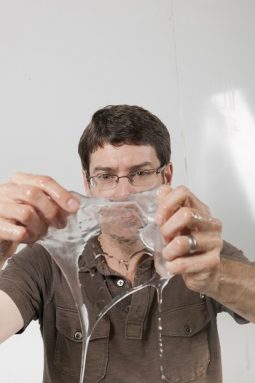Secrets of slime
Mucus may seem gross, but it’s a lifesaver for humans and other animals

Douglas Fudge (at right) studies the slime produced by hagfish, a sea creature that eats dead animals on the ocean floor.
Andra Zommers
By Roberta Kwok
Ugh, mucus. It drips out of your nose when you have a cold. You hack up gobs of it when you have a bad cough. It’s slimy, gooey and gross.
Why do our bodies make this disgusting stuff? It turns out that we need it to survive. Mucus helps rid us of bacteria and viruses that could sicken or even kill us. “It’s not fun, but it’s necessary,” says Brian Button. At the University of North Carolina (UNC) in Chapel Hill, he studies diseases that involve mucus.
Mucus is mostly water. It also contains salt and very large proteins called mucins (MEW-sins). Mucins are covered in sugar molecules. That gives them a negative electrical charge. That charge attracts other molecules to the mucins. It is similar to the way that tomato sauce clings to strands of spaghetti. And because the mucins are long, they get tangled up with each other. That’s why mucus is so gooey.
Your body produces mucus in your airways, lungs, nose, digestive system and lots of other places. “It lines basically every surface that your skin does not,” Button explains.

When you get a cold, your body makes extra mucus. This helps it fight the infection. Some mucus — also known as snot — dribbles out your nose. Again, this carries the pathogens out with it. Normally mucus is clear, but your body’s immune cells can make your snot turn white or yellow. Bacteria can even turn it green.
Other animals make mucus too. Some species have found different uses for it. For instance, snails ooze mucus to help them slide along the rough ground. Sea creatures called hagfish squirt out huge amounts of slime, made partly of mucus, to defend against predators. Still, there is much about this goo that science doesn’t understand. That’s why many scientists are now studying it.
Measuring mucus with gold
Some people have diseases that mess up mucus production. Patients with cystic fibrosis, for instance, make mucus that is too thick and gooey. It’s so viscous that the cilia have trouble moving the mucus back up to the throat. Instead, the mucus just sticks in huge gooey masses to the sides of the lungs’ airways.
Once the mucus is stuck, bacteria in it can flourish. That’s why cystic fibrosis patients often get infections. In time, parts of their lungs can die. That makes it hard for them to breathe.
Patients can take medicine to thin out the mucus. But doctors can’t easily tell if the drug is working. If they could somehow measure how runny a person’s mucus is, they could decide if or when a patient needed more treatment.
This idea captured Amy Oldenburg’s interest. “Can we measure the gooiness of mucus directly in the lung?” she asks. Oldenburg is a physicist at the UNC, where she works with Button.
In a 2014 study in the Proceedings of the National Academy of Sciences, they tried an unusual technique. They embedded mucus with gold.

The scientists reasoned these teensy rods could help measure mucus. When the experts shined light into mucus, they could observe how that light scattered off of the gold as the rods of it drifted through the mucus. It’s sort of like dropping jewelry into a swimming pool and watching it sparkle as the sunlight reflects off of the metal.
The rate of light flickering would tell the researchers how fast the rods were moving. The thicker the mucus, the more sluggishly they’d travel.
To test this, Oldenburg’s team collected mucus from lung cells that had been growing in the lab. They thinned out some mucus samples by adding salt water. Then the researchers added gold nanorods to the mucus and shone a laser on it.
As expected, the thicker the mucus was, the slower the rate of light flickering. That suggests that doctors could use this test to diagnose the state of a patient’s mucus.
Now Oldenburg and her colleagues are working on ways to deliver the gold nanorods to a patient’s lungs. For example, they might put the rods in a liquid spray that the person could inhale. A doctor could thread a very thin, flexible glass fiber through the patient’s nose or mouth into the lungs. Then the doctor could shine light down the fiber and measure the light reflected back.
Attack of the slimy snails
Snails use mucus quite differently — to travel. By squirting mucus onto the ground, they can push off the sticky goo and then slide along it. “Snails can’t go anywhere without producing slime,” explains John Orrock. He is a biologist at the University of Wisconsin-Madison.
Snails eat plants. A trail of slime could give plants a clue that a predator was nearby. Orrock wondered if plants could detect the slime left behind by a predatory snail.
You might think that plants wouldn’t be able to do anything with this information. After all, they can’t run away. But plants can defend themselves against attackers. For example, plants can produce chemicals to make their leaves taste bad.

Next, he grew black mustard. Garden snails love to dine on these plants. Orrock watered some plants with plain water and some with mucus-infused water. Then he put garden snails in buckets with the plants. Over the next couple of days, he recorded how much of each plant a snail ate.
The animals dined less on plants grown with mucus-infused water, Orrock found. Those plants indeed might have detected the mucus and produced chemicals to defend themselves from attack. Perhaps they had made themselves less tasty to the snails.
But Orrock had to rule out another explanation. Maybe the snails didn’t eat the mucus-treated plants because the snails detected some snail slime remaining in the soil. They might worry that another snail was nearby and think, “Oh man, as soon as I go near that plant, some big old snail is going to roll up out of nowhere and make my life difficult,” says Orrock.
So he performed another test. He put pieces of mucus-covered paper and regular paper in buckets and laid strips of cabbage on top. Then he placed snails into the buckets. Snails ate the cabbage on both types of paper. So mucus didn’t seem to scare them. Orrock now suspects his first explanation was correct: The snails hadn’t eaten the mucus-treated plants because the plants had somehow defended themselves.
His 2013 study, published in PLOS ONE, shows that plants do pay attention to snail mucus. It therefore appears that plants read a warning in the snail slime. “It means the chemicals you produce can be used against you,” Orrock concludes.
Underwater gross-out
Snails may seem pretty slimy, but they pale in comparison to hagfish. This eel-like creature feasts on dead animals at the bottom of the ocean. When threatened, it can spurt about a liter (one quart) of slime from the sides of its body. “We call them the champions of slime,” says Douglas Fudge. He’s a biologist at the University of Guelph in Canada.

Fudge wanted to know how hagfish made such amazing fibers. Cells that produce the fibers are only about 100-millionths to 125-millionths of a meter (about 0.004 to 0.005 inch) long. How could these cells make fibers some 1,000 times longer than themselves?
To find out, Fudge’s team collected fiber-producing cells from hagfish. Then the researchers studied the cells using powerful microscopes. They found interesting changes in a part of the cell called the nucleus. This compartment holds the animal’s DNA. Like an instruction manual, DNA tells each cell what molecules to make.
At first, the nucleus was shaped like a sphere. But as the cell made fibers, the nucleus began to grow more cone-shaped. Then the tip of the cone grew skinnier and pointier. The nucleus also shrank as the cell filled with fibers.
It looked as if the fibers were wrapping around the nucleus, like thread wound around a spool. That “spool” might keep the fibers from getting tangled when the hagfish shoots out slime, Fudge suspects. His team published its findings in the April 4, 2014 issue of Nature Communications.
By learning more about hagfish slime, Fudge might find out how to create similar materials in the lab. Because the fish’s slime fibers are so strong, synthetic versions might be created to make ropes or even bulletproof vests. These products are usually made from petroleum-based materials. Making and disposing of these oil-based materials can harm the environment. Fibers made in the lab might be more eco-friendly.
So here again, mucus may seem gross, although it can be very useful. So don’t look down your nose at it!
Power Words
(for more about Power Words, click here)
bacterium (plural bacteria) A single-celled organism. These dwell nearly everywhere on Earth, from the bottom of the sea to inside animals.
biology The study of living things. The scientists who study them are known as biologists.
cilia (singular cilium) Small hairlike features that occur on the surface of some cells and larger tissue structures. They can move and their wavelike motion can propel liquids to move in a particular direction. Cilia play an important role in many biological functions throughout the body.
cystic fibrosis A life-threatening disease that causes a buildup of sticky mucus in the lungs, digestive tract and other regions of the body. A defective gene leads to the production of extra-thick mucus, which can foster lung infections and digestive problems. Although millions of people carry the CF gene, only people who inherit a copy from each of their parents will actually go on to develop cystic fibrosis.
DNA (short for deoxyribonucleic acid) A long, double-stranded and spiral-shaped molecule inside most living cells that carries genetic instructions. In all living things, from plants and animals to microbes, these instructions tell cells which molecules to make.
germ Any one-celled microorganism, such as a bacterium, fungal species or virus particle. Some germs cause disease. Others can promote the health of higher-order organisms, including birds and mammals. The health effects of most germs, however, remain unknown.
hagfish Slimy, eel-shaped fish without hinging jaws, whose skeletons are made of bendy cartilage rather than hard bone, and with eyes far simpler than those of other fish. Like lampreys, they are considered to be “living fossils” similar to the early relatives of vertebrates that lived hundreds of millions of years ago.
laser A device that generates an intense beam of coherent light of a single color. Lasers are used in drilling and cutting, alignment and guidance, in data storage and in surgery.
molecule An electrically neutral group of atoms that represents the smallest possible amount of a chemical compound. Molecules can be made of single types of atoms or of different types. For example, the oxygen in the air is made of two oxygen atoms (O2), but water is made of two hydrogen atoms and one oxygen atom (H2O).
mucin A very large type of protein found in mucus. It is covered with many sugars and carries a negative electrical charge.
mucus A slimy substance produced in the lungs, nose, digestive system and other parts of the body to protect against infection. Mucus is made mainly of water but also includes salt and proteins such as mucins. Some animals use mucus for other purposes, such as to move across the ground or to defend themselves against predators.
nanoparticle A small particle with dimensions measured in billionths of a meter.
nucleus (plural nuclei) In biology: a dense structure present in many cells. Typically a single rounded structure encased within a membrane, the nucleus contains the genetic information.
pathogen An organism that causes disease.
physicist A scientist who studies the nature and properties of matter and energy.
predator (adjective: predatory) A creature that preys on other animals for most or all of its food
proteins Compounds made from one or more long chains of amino acids. Proteins are an essential part of all living organisms. They form the basis of living cells, muscle and tissues; they also do the work inside of cells. The hemoglobin in blood and the antibodies that attempt to fight infections are among the better known, stand-alone proteins. Medicines frequently work by latching onto proteins.
virus Tiny infectious particles consisting of RNA or DNA surrounded by protein. Viruses can reproduce only by injecting their genetic material into the cells of living creatures. Although scientists frequently refer to viruses as live or dead, in fact no virus is truly alive. It doesn’t eat like animals do, or make its own food the way plants do. It must hijack the cellular machinery of a living cell in order to survive.
viscous The property of being thick, sticky and hard to pour. Molasses and maple syrup are two examples of viscous liquids.
Word Find (click here to enlarge for printing)








